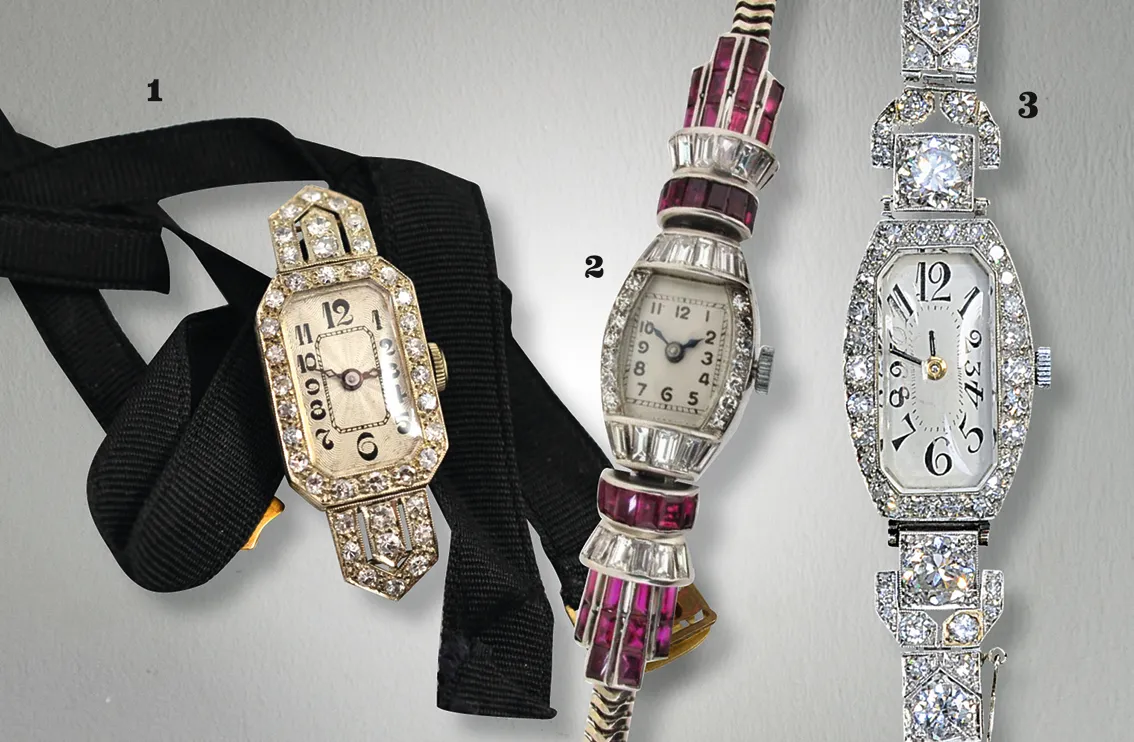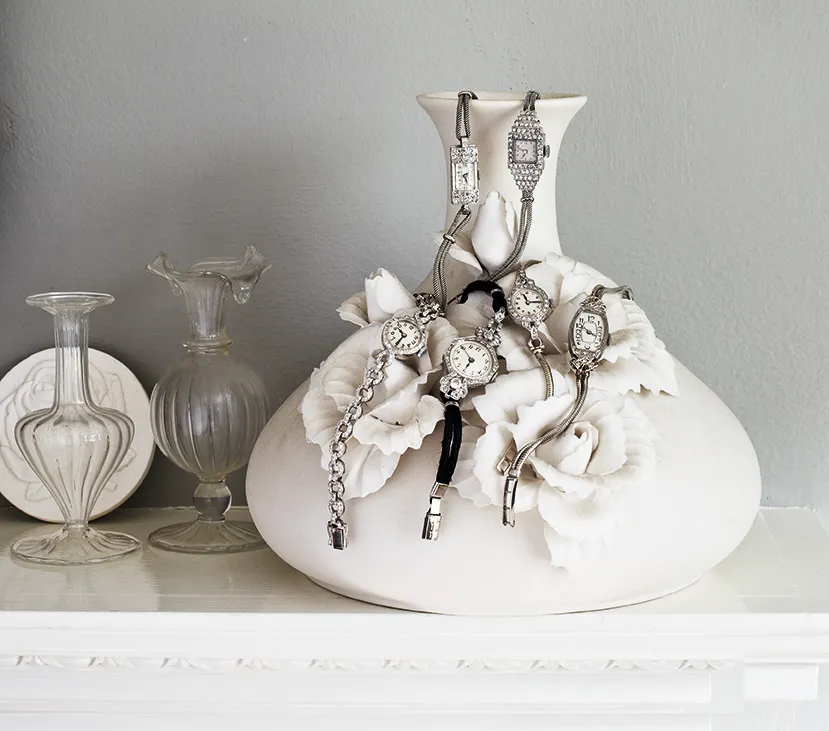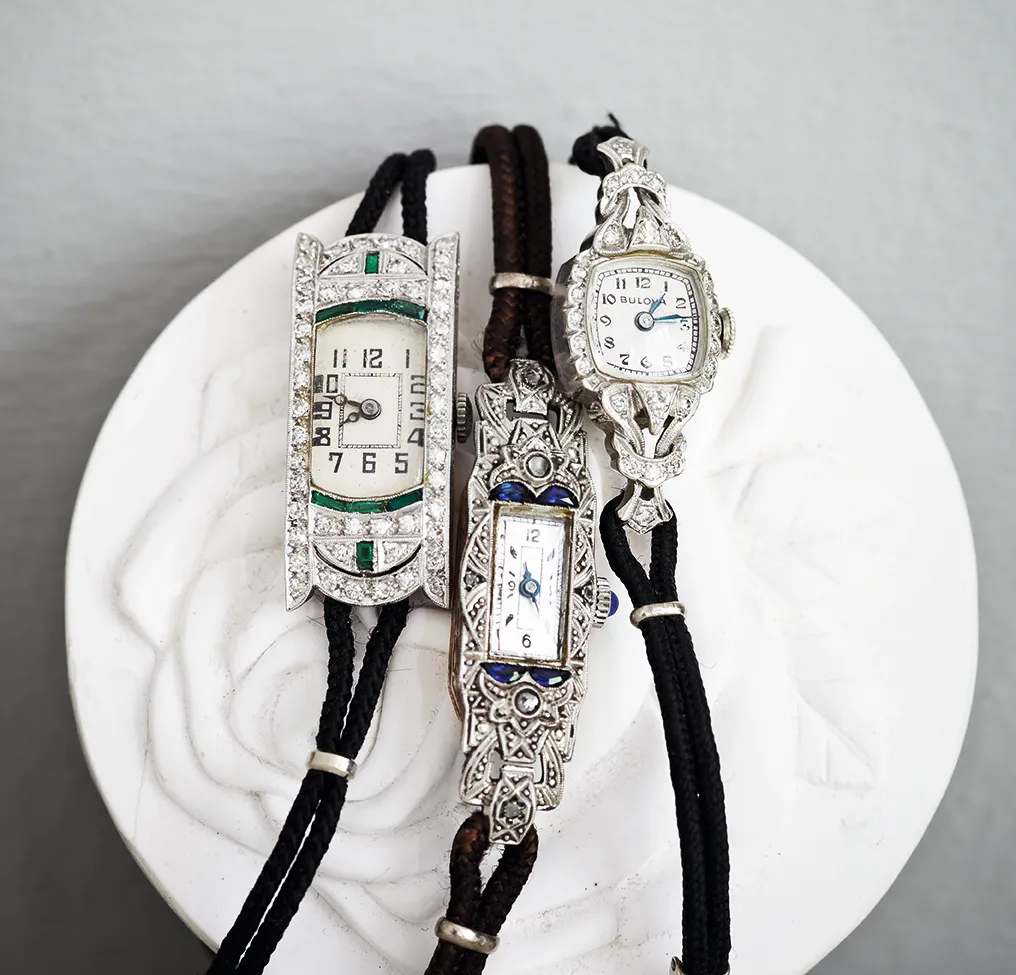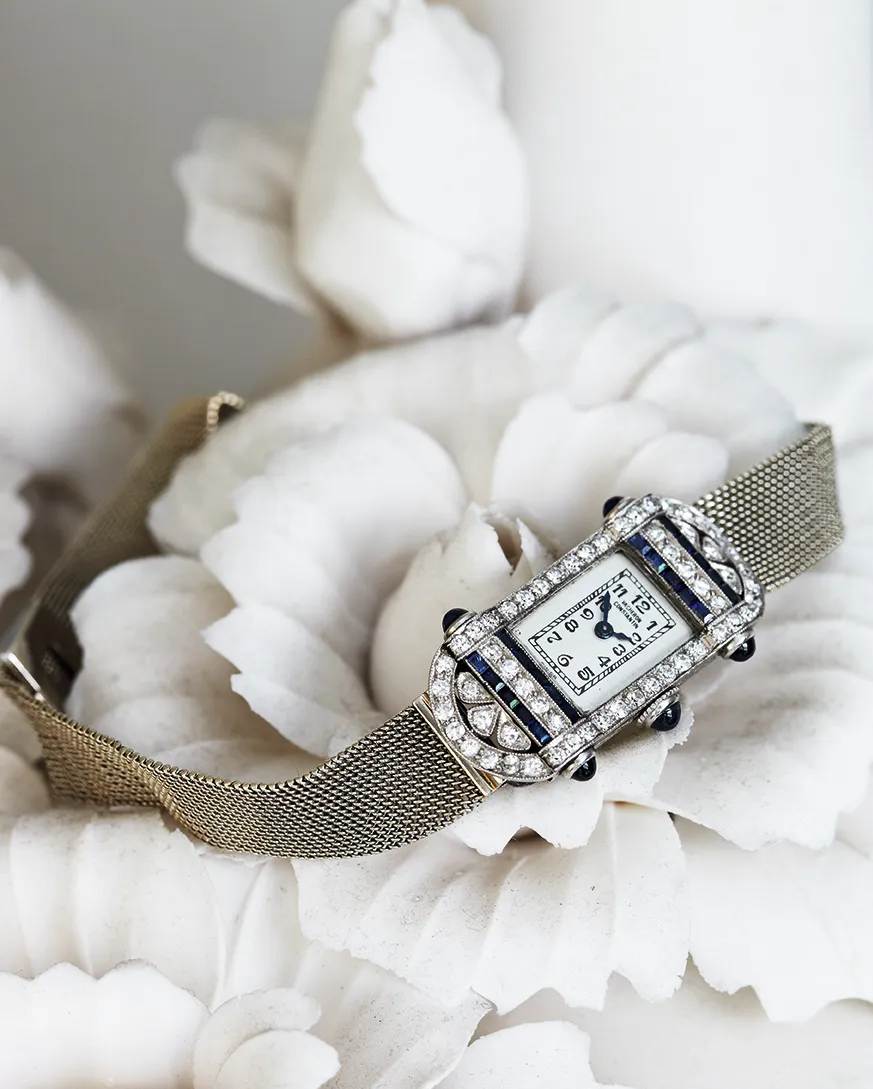Perusing a collection of antique ladies’ cocktail watches is like opening the door onto a long-lost world of old-fashioned romance and glamour.
Heart-felt sentiments hand-engraved onto the back of an elegant gold watch given ‘To Betty with love from Dan’ pay tribute to a forgotten love story.
And you can still imagine a jewel-laced watch being draped around the alabaster wrist of a 1930s screen siren on the opening night of her movie. What better way to mark a dazzling moment in time?
For over a century cocktail watches for ladies have combined functionality and beauty in one easy-to-wear piece, reaching their zenith in the highly decorative, often bejewelled ‘cocktail’ or ‘evening’ watch.
Add to this the horologist’s skill at engineering in miniature and it comes as no surprise that the interest in these timeworn masterpieces is rising.
When did cocktail watches become fashionable?
Records exist of Elizabeth I wearing a watch on her arm, but it wasn’t until the beginning of the 20th century that the cocktail watch really took off.
Prior to this high-society ladies could accessorise with intricately enamelled, bejewelled fob or pendant watches, a feminised version of a gentleman’s pocket watch.
But as the fashion for structured, corseted gowns waned, a new solution to the timepiece was sought. Delicate silk ‘flapper’ dresses, en vogue in the 1920s and 30s, could not withstand the weight of a fob watch, nor did they have pockets to carry one in.
Ladies required a multifunctional piece that was practical but punctuated their style. Wearing a timepiece on the wrist made it a quick and easy task to read the time for the busy, modern woman, especially during the outbreak of World War I when women had a new role to play, replacing men in the workforce.
Who were the biggest cocktail watch brands?
Brands such as Hamilton and Bulova were some of the most prolific manufacturers for the comfortable middle classes during the art deco and inter-war periods.
Their ranges embraced the new fashions for geometric, bold design and were a nod to the trends set by the more expensive brands such as Cartier and Rolex.
Their range and output was vast, catering for those looking for an everyday watch made from gold or silver, or for the lady who wanted to invest in a unique piece to pass down through her family.
Both companies are American but like most of the leading brands at the time, the movements were manufactured in Biel, Switzerland, the world capital of watchmaking.
At the top end of the market Rolex, Patek Philippe, Jaeger leCoultre and Cartier produced unrivalled timepieces made from expensive materials such as platinum and diamonds.
Cartier was responsible for introducing innovative shaped dials. Its ‘Tonneau’ watch (still in production today) was unlike anything before it with its curved oblong casing, while cleverly echoing their jewellery collections.
When were cocktail watches most popular?
The years of 1900 to 1930 witnessed the greatest output of women’s cocktail watches. As a relatively new phenomenon, demand was high and improvements in manufacturing techniques enabled watches to be produced quickly to coincide with rapidly changing tastes and fashions.
As horology developed, movements could be made smaller, allowing the strap and the case to take centre stage over the dial. Towards the end of this period, cocktail watches for ladies were treated as pieces of jewellery. In some designs the dial was concealed by a hinged flap, giving the impression of a bracelet, rather than a watch.
This was also the time when coloured gemstones such as rubies and sapphires were becoming available and were used to embellish cocktail watches with flamboyant colour.
Why are cocktail watches popular now?
The beautiful craftsmanship and quality of these watches is their main appeal. They were built by hand to last: the skill used in making early examples simply cannot be rivalled by modern machine-making techniques and buyers are becoming aware of this.
Designs have not dated and this makes them easy to wear today. Watches by a recognised name, or those set with expensive gemstones, are appealing for the brand-conscious buyer who wants a visible display of their wealth and taste.
For the price-sensitive collector, an antique, diamond cocktail watch is often a cheaper investment than a diamond bracelet. An original antique piece also provides assurance that the diamonds are unlikely to have been treated or enhanced in any way, unlike the gemstones of today.
What should I look for?
Quality varies tremendously as there has always been a need for a cocktail watch to suit every budget. ‘The key is to buy the best quality and most unusual example you can find within its range,’ says watch enthusiast Deborah Doyle. ‘Look out for clean dials and detailed, engraved decoration on silver cases – a sign of quality.’
Examples that have a name on the dial are always going to be more attractive as the manufacturer will have a following and a standard of quality that helps hold up the value.
Remember to check the length of the strap: ladies generally had smaller frames in the first part of the 20th century and it is common to find that watches from this period simply do not fit the modern woman’s wrist.
Is it worth repairing antique cocktail watches?
If you have bought a watch produced by a well-known manufacturer, it is usually possible to have it restored by the same company. All of the brands mentioned in this article still produce wristwatches and have service departments that can source parts such as new hands, straps and buckles and get a perfectly good watch cleaned and working again.
Most antique watches work on a winding mechanism rather than a battery, so it is simply a case of reviving the mechanics. Though this can be expensive, it is worth it if you are going to keep the watch and wear it for the long term. There is no reason why a serviced antique watch should be any less reliable than one made yesterday.
Today, what is sought-after?
Today’s desire for quality and brand recognition means that examples from top makers such as Patek Philippe or Rolex are the most sought-after.
Fewer of these top-end watches were produced as they were expensive to make and the onset of war limited production. Now demand outstrips supply so collectors are willing to pay huge sums to secure the perfect piece.
What is the price range?
‘It is easy to find an unbranded, diamond cocktail watch dating from around 1900 for as little as £150 at auction,’ says auctioneer Matthew Denney, ‘but it is a market that is quickly improving. Anything that is stylistically synonymous with a period, for example art deco, is instantly more desirable and will fetch a premium just because it is from that period.'
'Expect to pay between £100 and £300 for a plain 9ct gold Tudor wristwatch, a subsidiary company of Rolex. And for anything by the big names such as Cartier or Tiffany set with diamonds, you will definitely need a five-figure budget.’
Top of the tree

This classic watch is by Cartier, c1920, but could easily pass as a modern piece. The diamonds around the bezel are perfectly matched in colour and quality but it is the pearls on the strap that make it special.
At this date, the pearls would have been natural and not cultured making them more expensive than a single diamond of the same size. Today, the market for natural pearls has rocketed. This watch sold at Sotheby’s in 2013 for £20,000.
Three of the best

1. Good
The diamonds in this affordable watch frame the dial and hint at the symmetry about to be celebrated in the 1920s. As the strap is silk and not metal it is likely to be c1915-1925. It is worth £200.
2. Better
In this watch, baguette-cut rubies arranged in a fan shape add a splash of colour and are more important to the design than the much smaller dial. Baguette-cut stones were very fashionable at this time.
Their clean, simple lines gave a sophisticated and modern aspect to traditional watch wearing. This watch is probably c1940s-50s and is valued at £300-£400.
3. Best
Here the dial shape echoes Cartier’s revolutionary ‘Tonneau’ watch. The strap design is more intricate than that of the dial, illustrating the use of the watch as much as a piece of jewellery as for telling the time.
Its value lies in the two 0.5ct diamonds on each lug, but the size of the diamonds overall is much larger than most, making it particularly unique. It is worth around £2,000.
Where to buy cocktail watches
What to read
- How the Watch was Worn: A Fashion for 500 Years by Genevieve Cummins
- Miller’s Wristwatches: How to Compare and Value by Jonathan Scratchard




